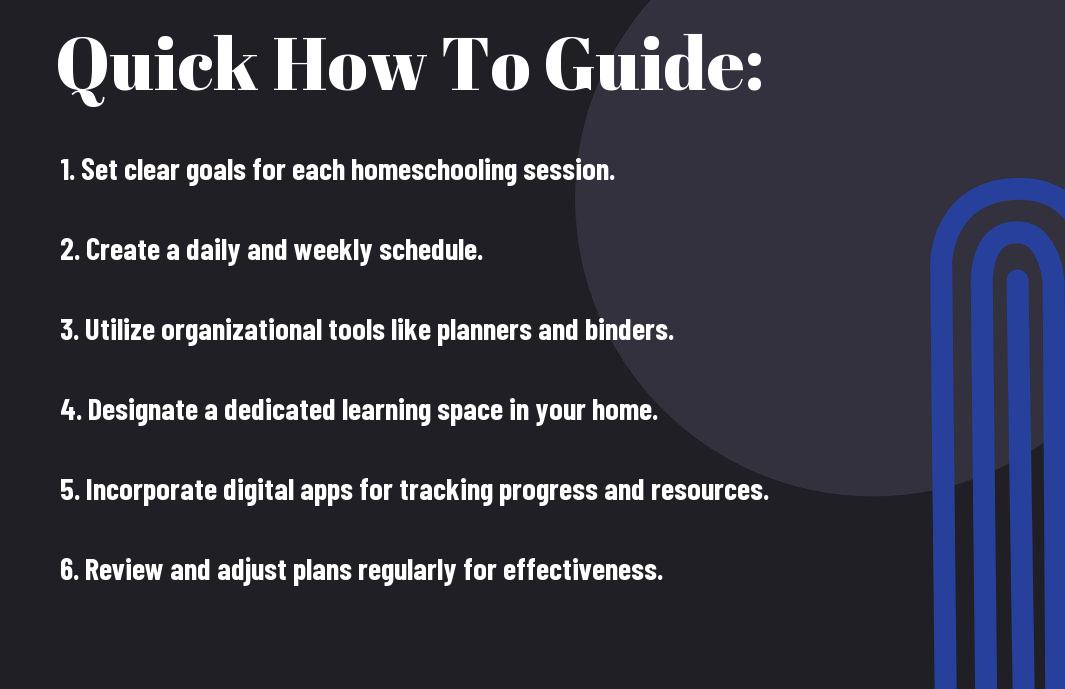You can create an effective and organized homeschooling experience by implementing a few strategic tools and techniques. With the right planning, you can prevent the overwhelm that often accompanies teaching at home. This guide will provide you with practical ways to streamline your lessons, manage your time wisely, and create an environment that fosters learning. Let’s explore how you can set up a system that works for you and your family, so you can focus on what truly matters: your children’s education.
Key Takeaways:
- Utilize digital tools such as calendars, task managers, and educational apps to streamline lesson planning and scheduling.
- Create a structured daily routine that incorporates dedicated time for teaching, breaks, and self-directed learning to maintain focus and productivity.
- Incorporate organizational techniques like binders, folders, or online storage systems to keep track of materials, assignments, and progress effectively.


Understanding the Importance of Organization in Homeschooling
While homeschooling offers unparalleled flexibility and personalized education, it also demands an effective organizational approach to ensure success. By maintaining a structured environment, you can enhance your efficiency, reduce stress, and create a learning atmosphere that fosters growth. Organization helps you to align your teaching methods and resources with your educational objectives, leading to a more productive and enriching homeschooling experience. An orderly environment empowers both you and your children to focus on learning, rather than dealing with the distractions that come from chaos.
Hence, cultivating an organized approach to your homeschooling journey is not merely beneficial; it’s crucial for maximizing the potential of both you and your child. With each element thoughtfully arranged and scheduled, you’ll find that your days flow more smoothly, and you can dedicate your time to what really matters—deepening knowledge and nurturing curiosity.
How to Identify Your Homeschooling Goals
With a plethora of educational resources and teaching styles at your disposal, it is key to clarify your specific homeschooling goals. Start by reflecting on what you hope to achieve—whether it’s fostering a love for learning, excelling academically, or developing life skills. Discuss these aspirations with your children to understand their interests and insights, allowing you to align your goals cohesively.
After determining your goals, consider mapping out a tailored plan that transitions those aspirations into actionable steps. This may include setting academic benchmarks, identifying necessary resources, or planning extracurricular activities that complement your educational mission. The clearer your goals, the easier it will be to structure your curriculum and daily routine, ensuring that your educational objectives remain the focal point of your homeschooling efforts.
Tips for Creating a Structured Environment
Little changes can have a profound impact on your organizational methods when setting up a structured environment for learning. First, create designated learning spaces that are free from distractions, stocked with all necessary materials to optimize your teaching efforts. Next, establish a consistent daily routine that includes both academic time and breaks, allowing your children to know what to expect and when to engage fully.
- Establish designated spaces for different subjects or activities.
- Create a consistent daily schedule outlining sessions and breaks.
- Incorporate visual aids to enhance understanding and motivation.
- Ensure basic supplies are easily accessible to minimize interruptions.
Assume that by implementing these tactics, you create not just a physical space but an inviting atmosphere where learning thrives. A solid, organized environment helps you maintain control over your lessons and minimizes feelings of overwhelm.
A structured environment can significantly influence the effectiveness of your homeschooling routine. By adhering to a clearly defined schedule and space for every subject, you encourage your children to adopt a sense of responsibility towards their learning. The emphasis on clarity and accessibility also reduces wasted time searching for materials or moving between chaotic areas. Additionally, having rules in place about the use of that space during educational activities fosters a strong framework for success. Assume that staying organized in your homeschooling practices will lead to a more enjoyable and effective educational experience for both you and your children.

Essential Tools for Staying Organized
Any homeschooling parent knows that staying organized is key to creating a successful learning environment. With the right tools and techniques at your disposal, you can manage your curriculum, schedules, and resources effectively. From planners and software to physical materials, there are numerous options available to help streamline your homeschooling process. Integrating these tools into your daily routine will not only help you stay organized but also enhance your productivity and ensure that your children’s educational needs are met.
How to Choose the Right Curriculum
Essential to any effective homeschooling strategy is selecting a curriculum that aligns with your educational philosophy and meets the specific needs of your children. Consider their learning styles, interests, and pace to ensure that the curriculum you choose will engage them and foster their love of learning. Additionally, explore various options, such as traditional textbooks, online programs, or project-based learning approaches, to find the best fit for your family.
Tools for Managing Schedules and Deadlines
Choose tools that allow you to maintain a clear overview of your homeschooling commitments, including schedules and deadlines for assignments or projects. Digital planners, calendar apps, and task management tools can be incredibly valuable in keeping both you and your children organized. These resources can help you allocate time effectively, ensuring that deadlines are met and important activities are prioritized.
Right tools for managing schedules and deadlines can dramatically improve your homeschooling experience. Using digital solutions like calendar apps enables you to set reminders for important dates and allocate time blocks for specific subjects. These tools help provide structure and clarity, allowing you to track progress and deadlines while encouraging accountability in your children. By leveraging the right technology, you can create a balanced approach to learning that minimizes stress and maximizes educational outcomes.
Developing Effective Study Routines
After establishing a welcoming home environment for learning, it’s imperative to develop effective study routines. Creating a structured approach to each learning day helps in building a sense of stability and predictability for you and your child. This not only boosts productivity but also enhances the overall learning experience. Little adjustments in daily schedules can lead to significant changes in how well your child retains information and engages with their studies.
Tips for Creating Consistent Learning Habits
After setting the stage for your homeschooling journey, you can foster consistent learning habits by implementing a few key strategies. Focus on establishing a regular study time that aligns well with your child’s peak focus hours. Consistency is your ally, and keeping a consistent schedule fosters a habit that your child can rely on. Here are a few suggestions to help you create those habits:
- Designate specific times for learning and breaks.
- Utilize a timer to create sessions with clear start and end points.
- Incorporate a variety of learning activities to keep engagement high.
Any shift from these patterns should be transitional, as abrupt changes might lead to confusion and loss of motivation.
Factors to Consider for Flexible Scheduling
Consider various aspects when designing your flexible schedule, as this approach allows you to adapt learning to fit your family’s needs. Every child has peaks and valleys in their focus and enthusiasm, which can be leveraged to maximize learning retention. Paying attention to your child’s unique rhythms will ensure that the schedule works for you both. Here are some factors to keep in mind:
- Assess your child’s energy levels throughout the day.
- Evaluate your family’s overall routine for disruptions.
- Factor in various learning styles and interests that fuel your child’s engagement.
After you’ve identified these factors, you can create a schedule that enhances productivity and maintains motivation, ultimately leading to a more successful homeschooling experience.
Habits formed during homeschooling are foundational for your child’s learning process. When you thoughtfully construct a flexible schedule around your child’s individual needs and family dynamics, you create an environment conducive to effective learning. Be mindful of, flexibility is about finding a balance that suits your rhythm while keeping educational objectives in sight. Here are some additional factors to consider:
- Be open to feedback from your child regarding when and how they prefer to learn.
- Give yourself space to adjust plans as needed to accommodate unexpected events.
- Incorporate opportunities for physical activity as natural breaks in learning.
After assessing and adjusting these elements, you’ll find that flexibility can yield a rewarding and fulfilling educational journey for both you and your child.

Utilizing Digital Resources
Your homeschooling journey can be transformed with the right digital resources at your disposal. The internet is bursting with tools designed to streamline lessons and enhance your teaching strategies. From educational platforms featuring video tutorials to interactive apps that make learning more engaging, these digital resources can significantly increase your efficiency. By incorporating technology into your curriculum, you can easily tailor your homeschool approach to fit your child’s unique learning style while keeping track of their progress with ease.
How-to Use Apps and Software for Homeschooling
For many homeschooling parents, utilizing apps and software can greatly simplify lesson planning and tracking your child’s academic performance. First, research and choose educational apps that align with your curriculum goals; many offer interactive content that can enhance retention and understanding. You can create a schedule within these platforms to auto-generate lesson plans, assign tasks, and send reminders when assignments are due. Additionally, using software that accommodates various age levels and learning styles enables you to cater to multiple subjects and developmental stages simultaneously.
Tips for Online Resource Management
Apps for managing your online resources can help consolidate your teaching materials, making it easier for you to find what you need when you need it. Consider investing in software that organizes your digital files and links based on subjects or grade levels, helping to streamline your workflow. A few effective suggestions include:
- Create folders for each subject to house all related materials.
- Use bookmarks for frequently visited educational websites.
- Implement a digital calendar to schedule classes and track assignments.
Any well-structured system can minimize stress and maximize productivity while schooling at home.
Understanding the power of effective online resource management will also serve you well in maintaining an organized homeschool environment. Develop a routine for regularly reviewing and updating the materials and resources you use. This not only keeps your planning relevant but also helps you identify any resources that may not be serving your educational goals. It’s imperative to assess the impact of each tool on your child’s learning experience and make necessary adjustments as needed. Keep an eye on what works and what doesn’t; this will show you how to maximize the benefits of digital resources. Any refinements to your approach can lead to a more productive and enjoyable homeschooling experience for both you and your children.
Organizing Learning Materials
Keep your homeschooling journey streamlined by effectively organizing learning materials. Having a structured system in place not only enhances your teaching experience but also makes learning more effective for your children. You can explore practical advice on How to Organize Your Homeschool for Stress-Free Days, which probes into various strategies to sort and store your educational resources efficiently.
How to Create a System for Physical Resources
Even the best resources can become a chaotic mess without a proper system for managing them. Start by categorizing your materials; consider using bins or shelves labeled by subject to easily find what you need when you need it. This system should include books, worksheets, supplies, and curriculum guides. Planning a specific day each week for reviewing and reorganizing can help keep everything tidy and ready for use.
Tips for Digital File Organization
Even in our digital world, keeping your virtual files organized is just as important as sorting physical materials. Set up a consistent naming convention for your files, making sure they are easy to identify and retrieve. Create folders for each subject and subfolders for lessons, student work, and resources. Prioritize keeping crucial documents backed up in cloud storage to protect against data loss.
- Utilize cloud storage options for accessibility.
- Implement a consistent naming convention for all files.
- Regularly review and update your organizational system.
Resources like templates and tools can also assist in developing a streamlined digital organization system. Use color-coding or tags to differentiate types of materials visually, which can save valuable time during lessons or when preparing for assessments. Assume that a well-structured digital environment will significantly enhance your workflow and reduce stress.
- Back up important files in cloud storage regularly.
- Keep digital resources sorted by subject for easier access.
- Use notes or comments to track file relevance and updates.
Monitoring Progress and Adjusting Strategies
For many homeschoolers, effectively monitoring academic progress is a vital component of ensuring success. You’ll want to implement systems that allow you to keep detailed records of your child’s learning achievements and challenges. Regular assessments, whether through quizzes, projects, or even informal discussions, can provide insights into what methods are working and which may require adjustments. Explore Simple Organizational Systems for Your Homeschool that … help streamline this process, making it easier for you to stay on top of your child’s education while minimizing stress and confusion.
How to Track Academic Progress
An effective way to track academic progress is by maintaining a comprehensive portfolio for each subject your child studies. This portfolio can include samples of their work, completed tests, and reflections on their learning experiences. Incorporating both qualitative and quantitative measures ensures you have a well-rounded understanding of your child’s progress, helping you to identify strengths and areas that may need more focus. Regular check-ins or open discussions with your child about their preferences in learning can also provide invaluable information in assessing their academic journey.
Factors Influencing Adjustments in Learning Plans
On your homeschooling journey, you may encounter various factors that influence decisions around adjusting your learning plans. Both academic performance and emotional well-being play significant roles in determining how best to tailor your educational strategies. Key aspects to consider include:
- Learning styles: Assessing how your child learns best can lead to more effective teaching methods.
- Confidence levels: If your child feels discouraged or overwhelmed, it may be time to adapt your approach.
- Interest and engagement: Keeping your child’s curiosity piqued is important for ongoing motivation.
- Time management: If your child struggles to keep up with schedules, revisiting timelines and goals might be necessary.
Perceiving these factors can guide your adjustments, making your homeschooling experience more effective and enjoyable for both you and your child.
It’s vital to maintain an open dialogue with your child about their experiences. Each factor that plays into their academic journey provides stepping stones to understanding their needs better. Look out for:
- Emotional responses: Recognizing when your child feels frustrated or elated can indicate their level of engagement.
- Feedback on materials: Asking how they feel about the resources you’re using can help tailor your curriculum.
- Progress rate: Monitoring how quickly they’re grasping new concepts will help you adjust the pace of learning.
- Limitations: Identifying specific areas where they require more support or challenge will guide curriculum choices.
Perceiving these signals will empower you to tweak your homeschooling strategies and create a more positive, productive learning environment.
Final Words
Ultimately, staying organized while homeschooling can significantly impact your educational experience and your child’s learning outcomes. By utilizing various tools and techniques, you create a structured environment that enhances both teaching and learning. Whether it’s through digital planners, printable schedules, or dedicated storage for educational materials, these resources can streamline your day-to-day activities and keep you focused on your educational goals. By adopting practical strategies, such as setting daily priorities and incorporating time management techniques, you establish a routine that works for you and your family.
Additionally, exploring more insights into How to Stay Organized in Your Homeschool can further enhance your organizational skills. The more informed you are about best practices and available tools, the better prepared you will be to navigate the complexities of homeschooling. Taking the time to refine your approach to organization will not only benefit you but will cultivate a more positive and productive learning atmosphere for your child.
Q: What are some effective tools for keeping track of homeschooling schedules and assignments?
A: One effective way to manage homeschooling schedules is by using digital planners or scheduling apps such as Google Calendar or Trello. These tools allow you to set up a daily and weekly agenda, assign tasks to specific days or times, and even send reminders for upcoming assignments or activities. Physical planners, such as bullet journals or printable planners, can also be utilized for a tactile approach. Incorporating color coding for different subjects or activities can enhance clarity and visual organization. It may also be beneficial to maintain a shared calendar with any other caregivers or family members involved in the homeschooling process, ensuring everyone is aware of the schedule.
Q: How can one create an effective and organized learning space at home?
A: Designing a dedicated learning space is imperative for maintaining focus and organization while homeschooling. Start by selecting a quiet area in your home where distractions are minimized. Equip this space with imperative supplies like books, writing materials, and technology tools, ensuring everything is readily accessible. Implement storage solutions, such as bins or shelves, to categorize materials based on subjects or activities. A consistent routine and clear boundaries about using the space can also contribute to a more organized environment. Personalizing the area with motivating visuals or educational posters can inspire and engage students further.
Q: What techniques can help manage multiple subjects and keep lessons engaging?
A: To manage multiple subjects effectively, consider using a thematic or project-based approach that integrates several subjects into one lesson plan. This technique allows students to see the connections between different topics, making learning more cohesive and engaging. Additionally, incorporating a variety of resources like videos, interactive online platforms, and hands-on activities can cater to different learning styles. Setting specific goals for each session or week and reviewing them regularly can also help gauge progress. Moreover, including breaks and flexibility in the schedule can prevent burnout and maintain enthusiasm for learning.

